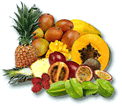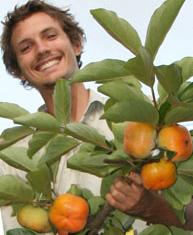
April 2008
The Daley News
Table of Contents
- Competition - Use your digital camera and get a $15 voucher just for entering + $100 Grand Prize Voucher.
- What's Fruiting in the Orchard - Persimmons, Pomegranates, Loquats
- Dr Paul Recher's Wild Jungle
- Angel Peach - NEW VARIETY
- Back to the Roots - documenting the native fruit trees of Western Turkey
 Dwarf Fruit Tree Competition Vouchers: $100 Prize and $15 Prize Just for entering
Dwarf Fruit Tree Competition Vouchers: $100 Prize and $15 Prize Just for entering
To enter simply take a picture of a dwarf fruit tree with fruit on it and with a person it the shot with a digital camera. Then upload it to this forum. Everyone who enters gets a $15 voucher and the grand winner get's an additional $100 Voucher. --> More Details <--
Fruiting in the Orchard - Pomegranates, Persimmons, Loquats...
There is lots happening in the orchard at the moment to tempt us down there to feast on the fruits ready for harvest. It is persimmon season again and we love this time of the year. The delicious deep orange delights are a favourite  amongst staff. The feijoas are cropping well and once again our efforts to control fruit fly have paid off and we are enjoying the fruits with out grubs. There are pomegranates just starting to come off and interestingly the Nagasakiwase loquat has thrown an out of season crop, these fruit normally come off in August, September but the unseasonal weather has prompted an Autumn crop this year. Thank you to all the people who responded to the last newsletter, we had a flood of messages come in. Michael Ward sent me this comment on how to tell when the time is right to pick the black sapote, from the December 07 newsletter.
amongst staff. The feijoas are cropping well and once again our efforts to control fruit fly have paid off and we are enjoying the fruits with out grubs. There are pomegranates just starting to come off and interestingly the Nagasakiwase loquat has thrown an out of season crop, these fruit normally come off in August, September but the unseasonal weather has prompted an Autumn crop this year. Thank you to all the people who responded to the last newsletter, we had a flood of messages come in. Michael Ward sent me this comment on how to tell when the time is right to pick the black sapote, from the December 07 newsletter.
"I just wanted to add to Kath's comments on when to pick Black Sapote (from our small experiences with our trees). We have found that when the flower cap on top of the fruit lifts slightly (a visible gap is noticable), then it is OK to pick. Before this and they wont ripen. I think they must be a near perfect fruit as they will stay with the raised flower cap on the tree for up to a month or so until they are required (or a figbird or bat can get a whole in one to bring on ripening). In this 'ready to pick' state they continue to be too hard for fruit fly (generally), and ripen within 3-5 days of picking.
small experiences with our trees). We have found that when the flower cap on top of the fruit lifts slightly (a visible gap is noticable), then it is OK to pick. Before this and they wont ripen. I think they must be a near perfect fruit as they will stay with the raised flower cap on the tree for up to a month or so until they are required (or a figbird or bat can get a whole in one to bring on ripening). In this 'ready to pick' state they continue to be too hard for fruit fly (generally), and ripen within 3-5 days of picking.
They are a really cool tree and tremendously hard working - with next year's flowers and then set fruit often on before this season's fruit are all off."
Dr Paul Recher's Wild Jungle Garden
At the beginning of March we piled into the bus and headed to Paul Recher's place in the Byron Hinterland for a tour. Paul has spent the last thirty years planting edible, useful and timber plants from around the world. As well as this he has a extensive  collection of ornamental flowering plants especially orchids, gingers and bromeliads. His garden has matured over the years into a jungle with specimen plants from almost every continent. I am sure that we only scratched the surface of what Pauls jungle contains in our three hour tour.
collection of ornamental flowering plants especially orchids, gingers and bromeliads. His garden has matured over the years into a jungle with specimen plants from almost every continent. I am sure that we only scratched the surface of what Pauls jungle contains in our three hour tour.
Paul planted his first tree in an open paddock on the day he purchased the piece of land, this was back on 1st July 1978 and since then he has extensively collected and planted. My list of notes from the day consists of three pages of misspelled latin names, least to say he knows all about his plants. There are water features, boat houses and lots of secret places to take in the views and scenery.
There were many highlights during the day, Greg was amazed at how the forest has matured to a full canopy since he first saw the property when it was a newly planted orchard twenty years ago. Chris was taken by the tung oil tree and used the fruit to oil his arm which he then spent the rest if the tour feeling the oil dry and set on his skin. Rick liked the giant Albizia tree and young Paul Daley and I like the spiny palms with their ornate decorations of spikes. We all had a chance to sample the delicious yellow tamarillos growing through the forest, I fell in love with tamarillos on this day and will have to stop calling them stinky boots from now on. The bamboo had quite an effect on us all, its varied colour, form and even the musical tones it produced when tapped created quite a buzz and uplifting atmosphere amongst us all. We were fortunate to see a pair of the endangered Richmond Birdwing butterflies at close hand which was also a great thrill.
his arm which he then spent the rest if the tour feeling the oil dry and set on his skin. Rick liked the giant Albizia tree and young Paul Daley and I like the spiny palms with their ornate decorations of spikes. We all had a chance to sample the delicious yellow tamarillos growing through the forest, I fell in love with tamarillos on this day and will have to stop calling them stinky boots from now on. The bamboo had quite an effect on us all, its varied colour, form and even the musical tones it produced when tapped created quite a buzz and uplifting atmosphere amongst us all. We were fortunate to see a pair of the endangered Richmond Birdwing butterflies at close hand which was also a great thrill.
 Thank you Paul for your wonderful hospitality, hoping we will have the chance to come back again and see some more.
Thank you Paul for your wonderful hospitality, hoping we will have the chance to come back again and see some more.
You too can tour Paul Rechers fabulous jungle garden, the cost is $20 plus $10 per adult, kids are free, for about 75 minutes minimum. Contact Paul to book a tour on recher@nrg.com.au or precher@bigpond.net.au or by phone on 02 66 895192.
 Angel Peach - Donut Peach - NEW VARIETY
Angel Peach - Donut Peach - NEW VARIETY
From the creators of the Dwarf Pinkabelle Apple Tree comes the Angel Peach Tree. It has been developed by PlantNet and will be available this winter 2008. So if you want to be one of the first Australians to grow this heavenly sweet new peach variety make sure you put your email address or mobile down to get notified the moment they are ready for sale.
Back To The Roots
My cousin Esin Isin works mapping and documenting the native fruit trees of the Mugla region, Western Turkey. Often beginning in the local market places Esin will find people selling their produce, she samples the fruit and asks if she can photograph the tree, its fruit and if they don't mind the owner of the tree. The fruits quality, size, flavour etc are documented. Esin details how the fruits are used, if they are eaten dried, fresh, and if they have been grafted and where the scion wood is sourced from. The tree is then mapped with a GPS. The results are a stunning collection of photographic documentation and a fascinating map showing the distribution of Turkeys native fruits and varieties. Growing in the region are pears, quince, olives, lemons, oranges, grapes, figs, pomegranates and watermelons. Some of the varieties are individual seed grown trees as you can imagine while other varieties are found over a wide area in Turkey. These trees would have parented many of the varieties that we now have in Australia, the Smyrna quince is a famous Turkish fruit. The variety of pears alone that are growing in the Mugla region in Turkey is quite astounding.
distribution of Turkeys native fruits and varieties. Growing in the region are pears, quince, olives, lemons, oranges, grapes, figs, pomegranates and watermelons. Some of the varieties are individual seed grown trees as you can imagine while other varieties are found over a wide area in Turkey. These trees would have parented many of the varieties that we now have in Australia, the Smyrna quince is a famous Turkish fruit. The variety of pears alone that are growing in the Mugla region in Turkey is quite astounding.
The project does more than just look at the fruits in the area covered it is also an  intimate look at the rich tapestry of culture, the relationship of the people to the fruit and the history of their heirlooms fruit trees that have fed generations of people in some cases. The significance of the project has not been missed by the United Nations who are one of the sponsors to the project enabling the research to continue. For anyone interested in having a look at the website here is the link, for the moment a grasp of Turkish language will help but there is to be an English Translation up shortly.
intimate look at the rich tapestry of culture, the relationship of the people to the fruit and the history of their heirlooms fruit trees that have fed generations of people in some cases. The significance of the project has not been missed by the United Nations who are one of the sponsors to the project enabling the research to continue. For anyone interested in having a look at the website here is the link, for the moment a grasp of Turkish language will help but there is to be an English Translation up shortly.





